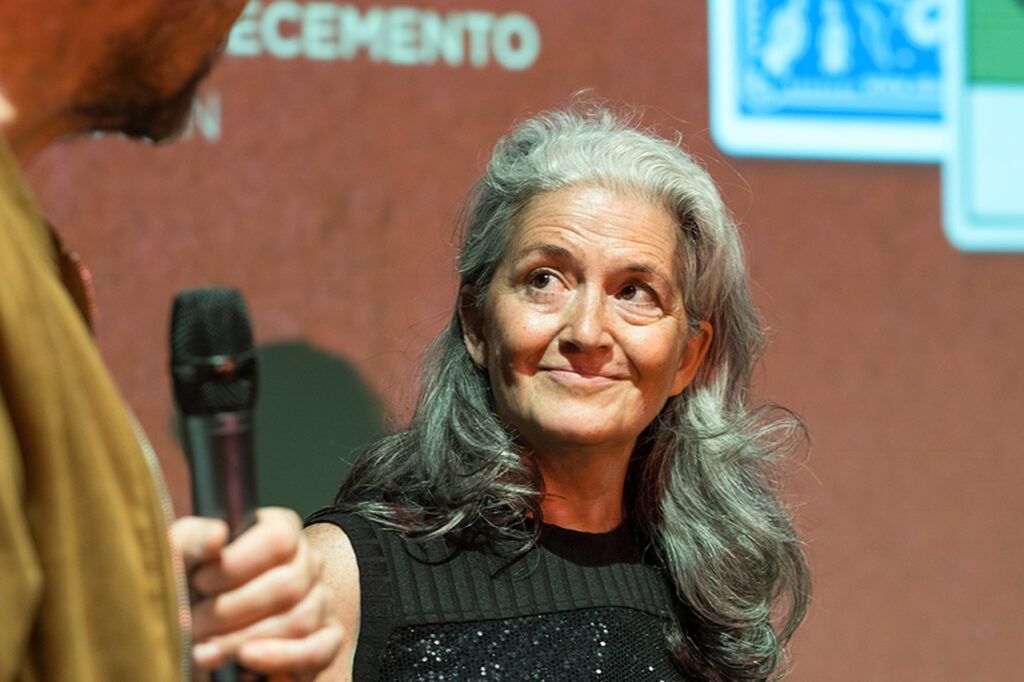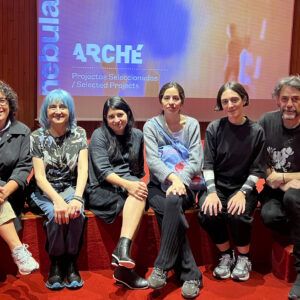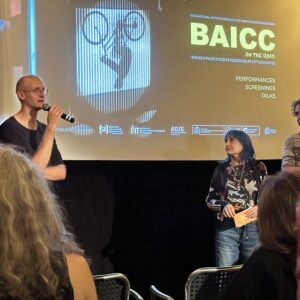
What drew you towards cinema in the first place? How did you decide to be a filmmaker?
While I’m not a purist (it’s all medium to me: film, digital, paint, ink, photo-chemistry, code…), what drew me to cinema was the physicality of film. I fell madly in love with the film object that you hold up to light so you see the discrete images the camera had captured, and to know that the moment is both held there as it is lost. Its permanence and transience. And I remain drawn to film’s body: the scratches, grain, and imperfections are old friends now. Film is both tactile and visual, it invites other senses by association, and we can share these sensations, impressions with others in a cinema or gallery.
I can’t locate exactly how/when I decided to dedicate myself to artistic practice… Like it is for most artists, making art is a necessity for me. I do other things that I also like to do for money: teaching, graphic design, arts administration. And I’ve raised two children. For a few years I didn’t make artwork and I was miserable, it was then that I finally committed to being an artist.
From where the idea for Cuentos de mi niñez came? How did you decide the formal approach and images of the film?
I made Cuentos in 1991 as an undergraduate student at Queen’s University, it was my thesis film. The process was intuitive. It was a story I needed to tell, I needed it to leave my body. I came to Canada as a refugee when I was six following the violent 1973 military coup in Chile that ousted elected president and socialist, Salvador Allende. This traumatic displacement – the experience of exile and its reckoning –left me with a sense of disquiet, never fully abated. I didn’t know this in my early 20’s, but this experience is integral to my artistic practice and how I see the world.
The Film Studies Department at Queen’s was relatively new in the late 1980’s and was a lovely, open-minded place to study. There was a practical component where we learned the conventions of filmmaking, but we weren’t pressured to use them. This freedom was a gift. We watched many Canadian and US experimental films. I was particularly drawn to artists like Joyce Weiland, Midi Onodera, Anne-Marie Fleming, Barbara Sternberg, Patricia Gruben, Trinh T Minh-ha and Maya Deren because they were women who made experimental personal, feminist, political works of art. The work of these artists gave me the courage to experiment.
The methodology and the collecting of sounds and images was nonlinear, what we now call “process-cinema,” as named by my friend and mentor Phil Hoffman. I folded people who were in my life at the time into the process. I had a written document that I read out loud and recorded. I went to Chile in the winter of 1990 with my family and brought a Bolex and 2 rolls of film. I knew I wanted to film La Moneda (presidential palace) and the Canadian Embassy in Santiago, but other than that I filmed what spoke to me at the time: shots out of the car window, landscapes, quiet moments on the airplane, that kind of thing. My brother Andrés and my cousin Amanda were my “crew” and are also in the film. I used to babysit the little girl, Ceilidh, who appears in the film: she lived with her parents in an anarchist intentional community that I used to spend time in. I added the animation, newspaper imagery, found-footage and text and did the optical printing as I rewrote the voice-over and edited. It was fluid, there was no real plan. The film is a recounting of my family’s flight from Chile, but it is also a portrait of who I was at the time and the people in my life. It is a very special film to me because of that.
From Boy, your work began to be closer to the material, manipulating the film. What inspired you for this?
Boy was shot, optically printed and edited in 1999 in Vancouver. It was supposed to be part of a programme of films called, “Vancouver at the turn of the century” commissioned by Cineworks Independent Film Society. The producer had some health problems and as a result, many of the films weren’t completed and those that were, did not screened together. I didn’t finish the film in 1999 for economic reasons. I rewrote and recorded the voice-over with actor Marilo Nuñez and finished the piece in 2005 when I was doing my MFA at York University.
I wanted Boy to appear wet, and have an immediacy or intimacy to it, and manipulation of the filmic surface through optical printing allowed me to get close to that goal. Rephotography also abstracts images as you delve into the substrate, like memory does. I drew inspiration aesthetically from paintings by John Turner, and a series of photos from the 1920’s by Vancouver photographer Jon van der Pant. At the time, my husband David was in architecture school. Our son Jacob was a toddler and I was his primary caregiver, and we spent a lot of time alone and in the company of other young children and mothers. Birthing and then caring for a young child changes your sense of time and it’s very messy and liquid: blood and amniotic fluid, then breast-milk, snot, urine, shit, and of course the baby’s food ends up all over their bodies and on you too. It also rains a lot in Vancouver and this water envelops you, it comes from everywhere, it doesn’t only fall from above. Boy is a kind of a love story: of film, of Jacob, of Vancouver.
In films such as It Matters What and Traje de luces your work with found footage. What is your relationship with archival materials and how did you find and select the images for these films?
I have always worked with found- imagery and sounds and images and audio that I capture. My work focuses on history, memory, power, and violence through the aperture of archives: curated and official; loosely assembled and accidental; familial and across communities. I am connected to communities of found-footage filmmakers in this way.
My family left Chile under duress. We didn’t bring photos from there. They were destroyed by the military when they ransacked our home. So televised, iconic, popular culture and all images became substitutes for me for what other families had. This experience left me with a broad understanding of how images might be repurposed in critical artworks and frameworks. You have an ethical responsibility to the source, content and to give credit where it is due, of course, but since I don’t make work for broadcast, I’ve never worried about copyright laws.
The images in Traje de Luces are from the Jacques Madvo Collection, material filmed in Spain between 1976-1983, when Spain began its difficult transition to democracy after Franco’s death. The project was made as part of a commissioning grant through LIFT. LIFT received a donation of documentarian Jacques Madvo’s works and out-takes. LIFT’s executive director Chris Kennedy wanted to do something meaningful with this collection and put out a call for interested filmmakers who might want to work with the material.
Madvo made a series of travel documentaries for Ontario’s public broadcaster, TVOntario. I hoped that there would be footage of Chile to work with in the Madvo collection, but there wasn’t. Working with material shot in Spain allowed me to probe commonalities between the Franco and Pinochet regimes which is something I had been interested in for many years. Pinochet admired Franco. Dictators learn from each other. I was also continuing my thinking about inequality, human rights, ecology, animal rights, colonialism, and the roots of fascism. I selected all the footage of corridas de toros (about 10 minutes) because to me, the imagery was iconic, nationalistic and violent and strongly communicated the themes I was exploring.
Traje de Luces is the fourth of my Retrato Oficial series, about the legacy of the former Chilean dictator, Augusto Pinochet. A legacy that remains alive today, even though Chile returned to democracy in 1989. I buried the film. The microbes in the soil that consumed the gelatin on the emulsion left their time marks. I rephotographed the decayed film using contact and optical printing techniques and hand-processed the results. I spent weeks in the darkroom with these difficult images, copying them, washing them, listening to podcasts about Trump’s first 2 years in office, Syria, the massive movement of refugees, ongoing reports about Canada’s inadequate response to indigenous people’s Truth and Reconciliation work.
For me, Traje de Luces has an elegiac quality. In retrospect, I was performing a funeral rite. The tension between the graphic violence of and materiality inscribed in the imagery calls into question at what point we turn away from or refuse to see humans presumed mastery over citizens, parent over child, other-than-human-species, and the land. It asks, how do we act when we encounter residues of violence?
It Matters What is a poetic manifesto responding to Donna Haraway’s essay “Tentacular Thinking: Anthropocene, Capitalocene, Chthulucene’‘ using phytograms, in-camera animation, contact printing, optical printing, text, voice, and soundscape. All the footage has been hand-processed using plant-based developers.
The found footage I experimented with was a gift from my sister-in-law Sue. She found it in a thrift store. It’s a 16mm reel from 1932 that came in a box, titled “at the lake”. On the reel are shots of 2 little girls who dance in the rain and a woman who runs her hand through her hair (which I have used in an animated loop). I chose a disturbing image of a woman who holds up a recently dead owl for the camera. This footage raises many questions for me in particular about the man who shot the footage. What is his relationship to the woman in the film? She is clearly uncomfortable as she “performs” for the camera. What is their relationship to this beautiful creature she holds? And again, the footage asks of us: what do we do when we encounter traces of violence?
One more thing on found footage: decay and rephotography processes diffuse and distort “found” representational images and their meanings. There is beauty (as well as information) in what these imperfections reveal about their production, exhibition, and archiving technologies. I approach digital and analogue found media in a similar way. I appreciate the accident and unpredictability of analogue film as well as its constraints, as much as I appreciate imagery produced on photocopiers, video static and roll bars and contemporary digital artifacts, especially with today’s obsession with resolution.
All your work has a very interesting political background, can you tell us about this and this evolved over the years?
Politics and our personal lives are intertwined. Issues can be unpacked and explored, but politics and our day-to-day lives cannot be separated. This subtext runs through my work. My first films were autobiographical. This ethos towards autobiography remains as the beings I encounter make their way into the work, whether evident or invisible and connected through process and place.
I remain invested in tactile, haptic intimacy and material experimentation originating through gestures of looking and documenting and in the results of that exploration: pleasurable, painful, difficult, complex, necessary.
I am interested in the traces left behind by political and economic systems, the relentless pursuit of progress, of capitalism and what these traces might reveal to us if we choose to look closely. In the past 10-15 years, my interests turned towards environmental concerns including how to practice art when a truly “sustainable” media art practice is impossible. Digital requires massive amounts of energy generated through server farms and rare earth minerals are extracted violently from the land by humans who are themselves exploited. Discarded technologies swamp landfill sites. Film emulsion contains gelatin which is an animal product and we haven’t begun talking about photo-chemistry…. These are some of the things that keep me awake at night.
About 6-years ago, I began working with plants and other humans in my art-practice, and specifically using eco-photo-chemical and printing techniques such as Karel Doing’s phytography technique. I spend a lot of time looking closely and considering plants and the gardens they create. Plants that are curated and those who grow anyway, uninvited, unwanted. I see this as a collaborative, quietly transgressive process. It forces us to challenge the idea of human-exceptionalism which is an urgent consideration right now.
We can imagine languages and narratives for other-than-human species, many of whom have been on earth longer than humans have been. But we lack the sophistication to interpret their communication systems, to understand their messages. And that condition of not-knowing is perhaps beautiful and a state of grace.
There is something that feels important about knowing how our materials are connected and to what and who they are connected, cataloging the overlapping strata of histories and voices even if we might not know how to interpret them and our intentions are contractionary, and mark-making, archiving, documenting thoughtfully in the face of climate change and an uncertain future.





